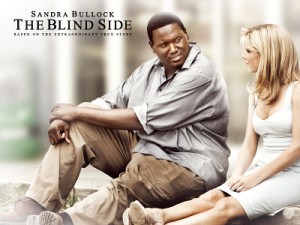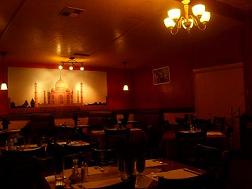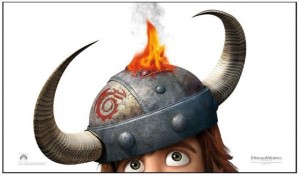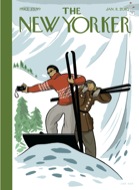 The Blind Side
The Blind Side
Every time I see a sports movie advertised, I groan. Gee, what could this be–yet another story about an individual who, through pluck and determination, overcomes great odds to yadda, yadda, yadda win the game, yea, go team?
Yawn.
I enjoy sports, but only those where the outcome really is in question. Only those where I don’t already know the story. If I want a scripted win, I can watch some long-hairs and freaks on WWF.
So you’ll understand why I didn’t rush out last year to see The Blind Side. What? A monstrously huge kid plays high school football as a lineman? Wow, he must have really worked hard at that. Is the paint still drying at the Zeyer’s house? Maybe I’ll go watch that instead.
And this was my response even though Sandra Bullock plays the leading role. I usually enjoy the movies Bullock stars in. Well, except for the last two–The Proposal and All About Steve–which I couldn’t bring myself to watch more than ten minutes of combined. But besides those, she’s probably been one of the most enjoyable actresses since Katherine Hepburn. This is because she actually plays real women, interesting characters, people with personality.
This is opposed to some actresses who don’t really play people at all, but are put in movies by directors who must think that if they can make the eyes bong out of male heads, those very males won’t notice that the story is dumber than a bag of rocks. These gals have lips that are so puffed up they look painful (e.g. Angelina Jolie, ouch, ouch, OUCH, somebody help her) or have seemingly nothing else to bring to the table besides their looks (e.g. Megan Fox, oooh, look at her shirt ride up over her belly, oooh, another shot of her eyes, oooh, white teeth), and so all their roles end up including very little besides posing for the camera so that we can see that, yes, Timmy, these women really were born with some mathematics, i.e. symmetry and facial proportions conforming to the golden ratio. Are your eyes bonging out yet, Timmy? See, that’s why you should study algebra and geometry. Math lets you do things like that.
Anyway, so it was a Bullock film, yet I still didn’t want to see it. But my real-man brother-in-law suggested it for a date night, and so I reluctantly went to watch. (Date night as in double date with the wives, not him and me. Sheesh, you people.)
I’m so glad I went. The movie was excellent. Probably because it was not about the plucky athlete winning the game, but about something far more important and enjoyable. It’s based on the true story of a rich southern white couple–Leigh Anne and Sean Tuohy–who try to take a homeless teenage African-American, Michael Oher (“Big Mike”), into their family. Michael’s mother is a crack head. His father is unknown. Michael himself is not doing very well. He’s failing school. He doesn’t even have a place to sleep sometimes. And he’s got the good old boys of his neighborhood wanting to hook him up with their gang and drug scene. But Leigh Anne soon takes charge.
And, boy, does she take charge. She’s one of the most delightful characters I’ve seen in a long time. I laughed again and again at her lines and personality. She also made me think about what I’m doing with my life. This woman and her family did something significant. I won’t tell you what happened with Michael–blah, blah, blah, yea, go team. You can find out for yourself. That wasn’t the important story here. The important story, the one that touched my heart and funny bone, was the one about a delightful family who went way out of its way to try to give a complete stranger a chance at a happy life.
Go see this show. No, it’s not in the theater, but you can buy or rent it. Me, I get all my films via Netflix. If you haven’t subscribed, consider it. Then you too can feel the excitement of seeing the happy little red Netflix envelopes waiting for you in your mailbox.
By the way, I have enjoyed a number of other great sports films over the years. If you like The Blind Side, I think you’ll enjoy Coach Carter, Miracle, Invincible, and Cool Runnings (a Brown family favorite).
 Blink by Malcolm Gladwell
Blink by Malcolm Gladwell
We are told to make decisions based on logic, not emotion. Reason must prevail. The closer we are to Spock, the better. At least in our decision-making, right?
Well, no. That’s actually wrong.
Over the last two decades researchers have found that the vast majority of our decisions are made by our gut, in the blink of an eye. And even those we make consciously, we make with a large input from our emotions. In fact, people who have the emotion centers in their brains damaged seem almost unable to make good decisions. Give them seven types of apples to choose from, and they can’t seem to pick one. Ask them to schedule an appointment, and they’ll go round and round listing the pros and cons of different dates and times. Let them know one deck of cards is stacked against them, and they still choose to play with it. They have logic, but lack judgment.
The rapid, emotional part of our brain is critical for good decision making. Of course, out guts can often be spectacularly wrong. In Blink, Malcolm Gladwell explores both sides of the choices we make in the blink of an eye.
But this is no tome of dry erudition. Gladwell writes with fantastic simplicity, clarity, and power. He explains what we now know about human decision-making by letting us meet the psychologist who has learned to predict whether a marriage will last, based on just a few minutes of observing the couple; the tennis coach who knows a player will double-fault before the racket even makes contact with the ball; and the art experts who can spot a fake at a glance. He helps us see why New Coke failed, how we pick presidents, and how it was possible that the police shot down Amadou Diallo, who was simply coming home one night. He shares the story of Paul Van Ripper who beat the Pentagon war-gamers in a massive defeat and why.
Blink reveals that great decisions makers aren’t those who have the biggest brains and highest IQ, but those who have perfected the art of “thin-slicing”—focusing in on the factors that make the biggest difference.
The book was fascinating. Read it. You’ll start seeing the world differently.
The Tandoori Oven
 While living in Orem, UT, Nellie and I got our first taste of Indian food. When we moved to the San Francisco area, we found a few Indian restaurants and really learned to love the cuisine. So you can imagine how excited we were when we moved up to boonieville Laketown and were told that just an hour away in Logan was a great Indian restaurant. So we followed the directions to the address we were given and ended up at the gas station just south of the USU football stadium on 720 East and 1000 North. And there above the gas station was the sign for the restaurant.
While living in Orem, UT, Nellie and I got our first taste of Indian food. When we moved to the San Francisco area, we found a few Indian restaurants and really learned to love the cuisine. So you can imagine how excited we were when we moved up to boonieville Laketown and were told that just an hour away in Logan was a great Indian restaurant. So we followed the directions to the address we were given and ended up at the gas station just south of the USU football stadium on 720 East and 1000 North. And there above the gas station was the sign for the restaurant.
We both looked at each other and rolled our eyes. Were the people who told us about this kidding?
But I decided to just go look. Sometimes the little holes-in-the-walls can surprise you. Maybe in the back by the Hostess rack and chips we’d find some great food. I entered the gas station and found it run by a pleasant Indian fellow. I thought, dang, we’ve got our very own Apu’s Quiki-Mart (Apu being one of my favorite characters on the The Simpsons). However, there was no restaurant. I looked around and saw nothing but racks of normal gas station snacks. I was confused. “I was told there was an Indian restaurant here?” I said.
“Right over here,” he said in his Indian accent and pointed me to an entryway in the far wall hung with strings of beads. “Through there.”
Intrigued, I passed through the beads and did indeed find a small restaurant. They’d simply sectioned off a part of the original gas station. I also found that there was a separate door to the outside which I’d missed. I examined the buffet, which looked pretty good, went outside and waved Nellie in. We were going to give it a shot. We let them seat us, and proceeded to enjoy a fabulous meal.
The restaurant is called The Tandoori Oven: http://TandooriOvenLogan.com. Nellie and I go there regularly. It’s been updated since the first time we went and dished up our soup into treacherous styrofoam bowls. Now they use real cutlery, but the good food and friendly service hasn’t changed.
If you know Indian food, you can go in the evenings and order a number of dishes to share. But if you want the best deal, go for lunch. They put on an all-you-can-eat buffet which will let you sample a number of dishes. We love the kurmas, saags, vindaloos, curries, naans, and, dude, the spinach soup! Heck, it’s all good. Especially when we can sweeten it a bit with their tamarind or mango chutney. And make sure you leave room for their saffron helwa (spiced cubes of farina) smothered with cardamom rice pudding for dessert.
 Bischoff Lotus Cookies
Bischoff Lotus Cookies
I recently performed a taste test. I got a package of Oreos and a package of Bischoff Lotus cookies, and I am here to state that the Bischoff Lotus cookies spanked the Oreos and sent them back to kindergarten for some schooling.
After the taste test, I had to force myself not to eat the rest of the Bischoff Lotuses in one sitting. I succeeded in lasting for two sittings. Yes, they’re that good—crisp, caramelized, sweet. They have none of the bitterness of gingersnaps, yet have enough spice to delight the tongue.
But these aren’t new cookies. The Dutch and Belgians have been enjoying them for years. Over there these types of cookies are called speculaas and are probably the most popular cookie around. I can testify they’re great with milk, hot chocolate, and Pero (hey, this is Mormon country). I understand they go great with coffee, even though I have not imbibed in that Aztec concoction and, therefore, cannot vouch for it personally. And for two years I enjoyed them, along with picturesque scenes of cobblestone streets, bicycles, and windmills.
When I came home, alas, I couldn’t find these delights anywhere except at specialty Dutch stores. And when we moved away from Utah, I never found them again. Then Delta Airlines started serving them on their flights. Oh, joy. But I don’t fly that often. So I’m excited to report that recently I was walking in Macey’s grocery store just across from the Stadium 8 movie theaters in Logan, scanning the packages along the cookie aisle and finding nothing appetizing, when the heavens parted, and a beam of light illuminated a white package with red lettering. I believe I heard a choir.
Bischoff Lotus cookies.
Could it be?
It was.
I heard reports they were also in Wal-Mart, but I didn’t see them there. So for the sure bet, go to Macey’s, buy, enjoy. And consider yourself Dutchified.


















